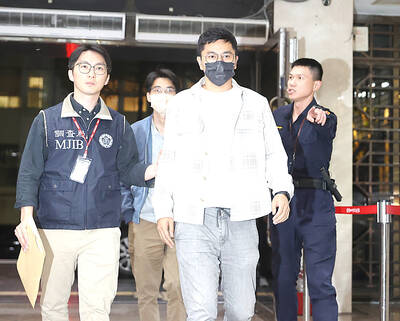China’s military thinking is outmoded and should learn from others, especially the US when it comes to modernizing its vast armed forces, a leading armed forces newspaper said yesterday.
A commentary in the People’s Liberation Army Daily said modernizing China’s military was central to reforms which have seen heavy investment in high-tech weapons like advanced fighter jets.
China has slimmed down its military, the world’s largest by number, over the past few years, trying to build a more effective force to face US-supplied Taiwan and Japan, as well as the US itself, but this needs creativity and more open thinking, the newspaper said, which could be a problem.
TRADITIONAL CULTURE
“Because conservative thinking has a rather large influence in traditional Chinese culture, the task of renewing its culture and rethinking the military will be extremely difficult,” it said.
China had to “audaciously learn from the experience of the information cultures of foreign militaries,” it said.
“History and reality have shown again and again that a country which does not have a world view is a backward one. A military which lacks global vision is one without hope,” it said.
The US was a good example to follow in two regards, the article added.
The US military buys technology already available on the open market when it can, such as global positioning systems used in the Gulf War, a cheaper and more practical method than trying to develop such equipment itself, the commentary said.
In addition, the US pays a lot of attention to training, “enlisting large numbers of able-bodied men and boldly using them,” it said.
LESSONS LEARNED
The Chinese military looked on with horror during the first Gulf War in 1990 and 1991, when US guided missiles and precision bombs easily took out Iraqi equipment such as tanks, much of it similar to what China was using at the time.
Since then the People’s Liberation Army has come on in leaps and bounds, though analysts say poor training and coordination among different branches of the military remain serious challenges.
During last year’s national day parade, China showed off its DongFeng 21C missile, which could force US aircraft carriers to keep a greater distance if it is successfully developed into an anti-ship ballistic missile.
That would make it harder for the US to come to Taiwan’s aid in the event of a conflict.

Seventy percent of middle and elementary schools now conduct English classes entirely in English, the Ministry of Education said, as it encourages schools nationwide to adopt this practice Minister of Education (MOE) Cheng Ying-yao (鄭英耀) is scheduled to present a report on the government’s bilingual education policy to the Legislative Yuan’s Education and Culture Committee today. The report would outline strategies aimed at expanding access to education, reducing regional disparities and improving talent cultivation. Implementation of bilingual education policies has varied across local governments, occasionally drawing public criticism. For example, some schools have required teachers of non-English subjects to pass English proficiency

‘FORM OF PROTEST’: The German Institute Taipei said it was ‘shocked’ to see Nazi symbolism used in connection with political aims as it condemned the incident Sung Chien-liang (宋建樑), who led efforts to recall Democratic Progressive Party (DPP) Legislator Lee Kun-cheng (李坤城), was released on bail of NT$80,000 yesterday amid an outcry over a Nazi armband he wore to questioning the night before. Sung arrived at the New Taipei City District Prosecutors’ Office for questioning in a recall petition forgery case on Tuesday night wearing a red armband bearing a swastika, carrying a copy of Adolf Hitler’s Mein Kampf and giving a Nazi salute. Sung left the building at 1:15am without the armband and apparently covering the book with a coat. This is a serious international scandal and Chinese

TRADE: The premier pledged safeguards on ‘Made in Taiwan’ labeling, anti-dumping measures and stricter export controls to strengthen its position in trade talks Products labeled “made in Taiwan” must be genuinely made in Taiwan, Premier Cho Jung-tai (卓榮泰) said yesterday, vowing to enforce strict safeguards against “origin laundering” and initiate anti-dumping investigations to prevent China dumping its products in Taiwan. Cho made the remarks in a discussion session with representatives from industries in Kaohsiung. In response to the US government’s recent announcement of “reciprocal” tariffs on its trading partners, President William Lai (賴清德) and Cho last week began a series of consultations with industry leaders nationwide to gather feedback and address concerns. Taiwanese and US officials held a videoconference on Friday evening to discuss the

PERSONAL DATA: The implicated KMT members allegedly compiled their petitions by copying names from party lists without the consent of the people concerned Judicial authorities searched six locations yesterday and questioned six people, including one elderly Chinese Nationalist Party (KMT) member and five KMT Youth League associates, about alleged signature forgery and fraud relating to their recall efforts against two Democratic Progressive Party (DPP) legislators. After launching a probe into alleged signature forgery and related fraud in the KMT’s recall effort, prosecutors received a number of complaints, including about one petition that had 1,748 signatures of voters whose family members said they had already passed away, and also voters who said they did not approve the use of their name, Taipei Deputy Chief Prosecutor